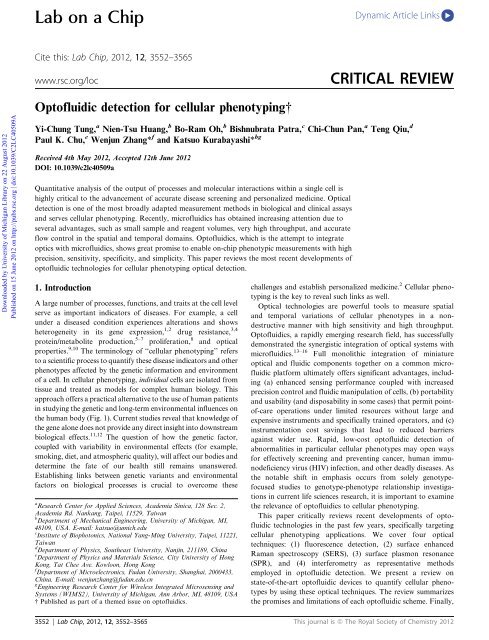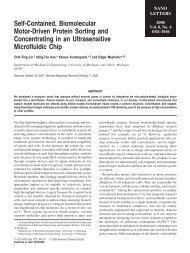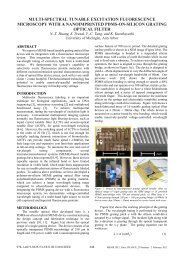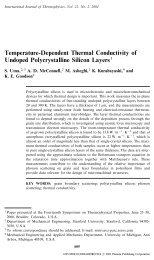Miniaturisation for chemistry, physics, biology, materials science and ...
Miniaturisation for chemistry, physics, biology, materials science and ...
Miniaturisation for chemistry, physics, biology, materials science and ...
You also want an ePaper? Increase the reach of your titles
YUMPU automatically turns print PDFs into web optimized ePapers that Google loves.
Downloaded by University of Michigan Library on 22 August 2012<br />
Published on 15 June 2012 on http://pubs.rsc.org | doi:10.1039/C2LC40509A<br />
Lab on a Chip<br />
Cite this: Lab Chip, 2012, 12, 3552–3565<br />
Optofluidic detection <strong>for</strong> cellular phenotyping{<br />
Yi-Chung Tung, a Nien-Tsu Huang, b Bo-Ram Oh, b Bishnubrata Patra, c Chi-Chun Pan, a Teng Qiu, d<br />
Paul K. Chu, e Wenjun Zhang* f <strong>and</strong> Katsuo Kurabayashi* bg<br />
Received 4th May 2012, Accepted 12th June 2012<br />
DOI: 10.1039/c2lc40509a<br />
Quantitative analysis of the output of processes <strong>and</strong> molecular interactions within a single cell is<br />
highly critical to the advancement of accurate disease screening <strong>and</strong> personalized medicine. Optical<br />
detection is one of the most broadly adapted measurement methods in biological <strong>and</strong> clinical assays<br />
<strong>and</strong> serves cellular phenotyping. Recently, microfluidics has obtained increasing attention due to<br />
several advantages, such as small sample <strong>and</strong> reagent volumes, very high throughput, <strong>and</strong> accurate<br />
flow control in the spatial <strong>and</strong> temporal domains. Optofluidics, which is the attempt to integrate<br />
optics with microfluidics, shows great promise to enable on-chip phenotypic measurements with high<br />
precision, sensitivity, specificity, <strong>and</strong> simplicity. This paper reviews the most recent developments of<br />
optofluidic technologies <strong>for</strong> cellular phenotyping optical detection.<br />
1. Introduction<br />
A large number of processes, functions, <strong>and</strong> traits at the cell level<br />
serve as important indicators of diseases. For example, a cell<br />
under a diseased condition experiences alterations <strong>and</strong> shows<br />
heterogeneity in its gene expression, 1,2 drug resistance, 3,4<br />
protein/metabolite production, 5–7 proliferation, 8 <strong>and</strong> optical<br />
properties. 9,10 The terminology of ‘‘cellular phenotyping’’ refers<br />
to a scientific process to quantify these disease indicators <strong>and</strong> other<br />
phenotypes affected by the genetic in<strong>for</strong>mation <strong>and</strong> environment<br />
of a cell. In cellular phenotyping, individual cells are isolated from<br />
tissue <strong>and</strong> treated as models <strong>for</strong> complex human <strong>biology</strong>. This<br />
approach offers a practical alternative to the use of human patients<br />
in studying the genetic <strong>and</strong> long-term environmental influences on<br />
the human body (Fig. 1). Current studies reveal that knowledge of<br />
the gene alone does not provide any direct insight into downstream<br />
biological effects. 11,12 The question of how the genetic factor,<br />
coupled with variability in environmental effects (<strong>for</strong> example,<br />
smoking, diet, <strong>and</strong> atmospheric quality), will affect our bodies <strong>and</strong><br />
determine the fate of our health still remains unanswered.<br />
Establishing links between genetic variants <strong>and</strong> environmental<br />
factors on biological processes is crucial to overcome these<br />
a<br />
Research Center <strong>for</strong> Applied Sciences, Academia Sinica, 128 Sec. 2,<br />
Academia Rd. Nankang, Taipei, 11529, Taiwan<br />
b<br />
Department of Mechanical Engineering, University of Michigan, MI,<br />
48109, USA. E-mail: katsuo@umich.edu<br />
c<br />
Institute of Biophotonics, National Yang-Ming University, Taipei, 11221,<br />
Taiwan<br />
d<br />
Department of Physics, Southeast University, Nanjin, 211189, China<br />
e<br />
Department of Physics <strong>and</strong> Materials Science, City University of Hong<br />
Kong, Tat Chee Ave. Kowloon, Hong Kong<br />
f<br />
Department of Microelectronics, Fudan University, Shanghai, 2000433,<br />
China. E-mail: wenjunzhang@fudan.edu.cn<br />
g<br />
Engineering Research Center <strong>for</strong> Wireless Integrated Microsensing <strong>and</strong><br />
Systems (WIMS2), University of Michigan, Ann Arbor, MI, 48109, USA<br />
{ Published as part of a themed issue on optofluidics.<br />
Dynamic Article Links<br />
www.rsc.org/loc CRITICAL REVIEW<br />
challenges <strong>and</strong> establish personalized medicine. 2 Cellular phenotyping<br />
is the key to reveal such links as well.<br />
Optical technologies are powerful tools to measure spatial<br />
<strong>and</strong> temporal variations of cellular phenotypes in a nondestructive<br />
manner with high sensitivity <strong>and</strong> high throughput.<br />
Optofluidics, a rapidly emerging research field, has successfully<br />
demonstrated the synergistic integration of optical systems with<br />
microfluidics. 13–16 Full monolithic integration of miniature<br />
optical <strong>and</strong> fluidic components together on a common microfluidic<br />
plat<strong>for</strong>m ultimately offers significant advantages, including<br />
(a) enhanced sensing per<strong>for</strong>mance coupled with increased<br />
precision control <strong>and</strong> fluidic manipulation of cells, (b) portability<br />
<strong>and</strong> usability (<strong>and</strong> disposability in some cases) that permit pointof-care<br />
operations under limited resources without large <strong>and</strong><br />
expensive instruments <strong>and</strong> specifically trained operators, <strong>and</strong> (c)<br />
instrumentation cost savings that lead to reduced barriers<br />
against wider use. Rapid, low-cost optofluidic detection of<br />
abnormalities in particular cellular phenotypes may open ways<br />
<strong>for</strong> effectively screening <strong>and</strong> preventing cancer, human immunodeficiency<br />
virus (HIV) infection, <strong>and</strong> other deadly diseases. As<br />
the notable shift in emphasis occurs from solely genotypefocused<br />
studies to genotype-phenotype relationship investigations<br />
in current life <strong>science</strong>s research, it is important to examine<br />
the relevance of optofluidics to cellular phenotyping.<br />
This paper critically reviews recent developments of optofluidic<br />
technologies in the past few years, specifically targeting<br />
cellular phenotyping applications. We cover four optical<br />
techniques: (1) fluorescence detection, (2) surface enhanced<br />
Raman spectroscopy (SERS), (3) surface plasmon resonance<br />
(SPR), <strong>and</strong> (4) interferometry as representative methods<br />
employed in optofluidic detection. We present a review on<br />
state-of-the-art optofluidic devices to quantify cellular phenotypes<br />
by using these optical techniques. The review summarizes<br />
the promises <strong>and</strong> limitations of each optofluidic scheme. Finally,<br />
3552 | Lab Chip, 2012, 12, 3552–3565 This journal is ß The Royal Society of Chemistry 2012





